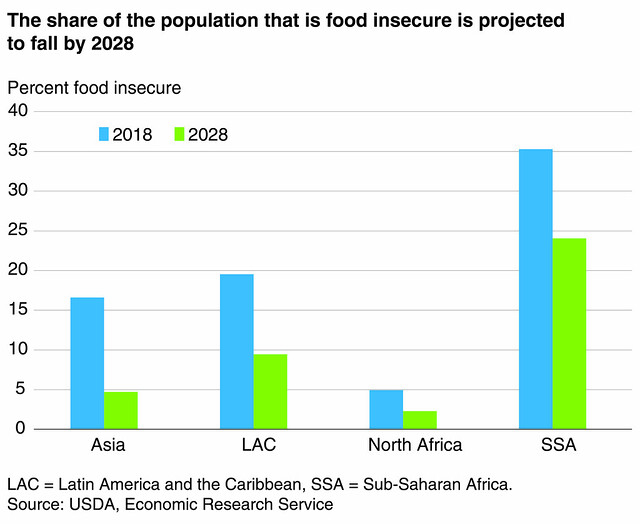
In 2018, 21 percent of the 3.7 billion people in 76 low- and middle-income countries do not have access to sufficient food for an active and healthy life, i.e. not food secure. However, by 2028, only 10 percent of the projected 4.3 billion people in these countries will be food insecure.
USDA’s Economic Research Service recently released the annual International Food Security Assessment 2018-2028, which measures and projects food security in 76 low- and middle-income countries that receive or have received U.S. food aid.
Why do we monitor and measure global food security? This report helps us understand the causes of global food insecurity and agencies determine countries where food aid is needed. For example, Yemen and South Sudan and parts of several other countries have suffered from famines in 2018 alone. In many other countries, poverty rates are high and people cannot afford food. In order to address chronic food insecurity, we need a way to measure the extent of food insecurity in order to target the countries where progress is or is projected to be slow.
The 782 million people without access to sufficient food in 2018 are not spread evenly across countries and regions. The chart shows the share of the population that is food insecure by region and the projected change by 2028. In 2018, the share of population that is food insecure is relatively low in Asia (17 percent) and Latin America/Caribbean (20 percent). However, in Sub-Saharan Africa 36 percent of the population remains food insecure. This regional disparity is projected to widen into 2028 when Sub-Saharan Africa is expected to still have 24 percent of its population food insecure.
Several countries are not likely to make significant progress in improving their food security situation because of factors such as conflict and natural disasters, which have created refugees, diminished agricultural livelihoods, limited access to food, and stymied overall economic growth. Most of Yemen is food insecure, and repeated closure of ports makes it difficult for food to enter the country. Over half the population in Central Africa is projected to be food-insecure in 2028, following years of civil conflict in DR Congo and Central African Republic.
The conflict in Central Africa has spilled over into neighboring countries that host refugees. East Africa hosts almost 5 million refugees from these conflicts and from South Sudan, as well as people displaced by persistent drought in the Horn of Africa. However, other countries that host these refugees, such as Uganda, Ethiopia, and Kenya, have well-functioning markets despite droughts in previous years, and are projected to continue to improve their food security situations following diversified economic growth.
